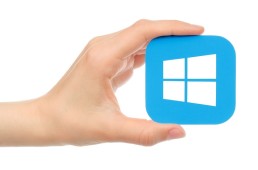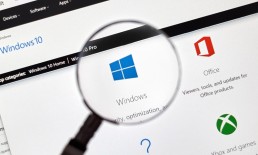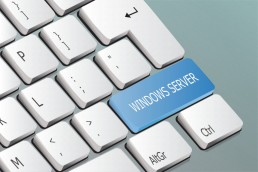Installing Windows Server - it's quick and easy!
Installing Windows Server - it's quick and easy!
Windows Server installation – the preparation
Before you can install the Windows Server, you must ensure that the most important system requirements are met. In addition, the device drivers should be updated so that the installation of, for example, Windows Server 2022 is possible without complications. These two steps serve as preparation for installing the Windows Server and should be followed regardless of the respective Windows Server versions.
System requirements
The system requirements for the new Windows Server are primarily directed at the hardware components. They include the following points:
- 64-bit processor with 1.4 GHz.
- Compatible with x64 instruction set.
- 512 MB or 2 GB, respectively, should the installation option „desktop display“ be selected.
- ECC (Error Correcting Code) type or equivalent for physical host provisioning.
- Support for NX and DEP.
- CMPXCHG16b, LAHF/SAHF and PrefetchW supported.
- Second Level Address Translation (EPT or NPT) support.
Important: Regardless of the system requirements, the necessary Windows Server CALs should be available. Only then can the new version of Win Server be used as desired.
Update device drivers
If all system requirements are met, it makes sense to update the device drivers. By installing the latest drivers, you can ensure that they work properly with the current server.
Windows Server – Installation and Configuration
The installation of the new Windows Server works in the familiar way: It is delivered with the Windows Installer and can then be installed in two ways. Those who are familiar with the command line can use it for the installation, otherwise a GUI is available. After successful installation, the user finds himself on the desktop, which directly integrates the Microsoft Edge browser. The desired configurations can be made via the Server Manager, whereby the developers have hardly changed the interface. The Windows Admin Center, on the other hand, has been updated and looks more modern and appealing. All in all, both the installation and the configuration work as in previous years. This means that it remains easy to use for most administrators.

More security with Windows Server 2022
While there are some functional innovations in the new Windows Server version – the focus is on the significantly increased security level.
- The multi-layered Secured Core security features provide increased protection against modern cyber-attack threats. These functionalities extend across the operating system, firmware and hardware: a plus point that quickly makes itself felt in the company.
- Preventive defence mechanisms help companies protect their sensitive information. In doing so, they detect advanced malware at an early stage and ward it off, which could otherwise manipulate the system.
- Advanced Threat Protection helps detect and stop data leaks, network attacks and zero-day vulnerabilities.
- Windows Defender Exploit Guard prevents intrusion attempts that target the host.
- Virtualisation-based security prevents attackers from introducing malware should they wish to exploit a vulnerability in the operating system.
- End-to-end encryption ensures that data is secure on untrusted networks
What to do after the Windows Server installation
To ensure that the new server functions properly, the most important points should be observed after the installation. This includes, for example, installing the latest updates provided by Microsoft’s update server. The group policies must also be set and the range of functions adjusted as desired. In addition, the following steps are important.
- Load and optimise workload templates: Those who decide to use templates should optimise them afterwards. Since they are designed to be used in a wide variety of companies, they will certainly differ from the actual requirements of the company.
- Set settings for virtualisation in the BIOS: These settings should always be checked separately. Especially if the server is to run Hyper-V, the most important adjustments must be made.
- Update drivers: Missing drivers for different devices may need to be installed. On the other hand, those that are not up to date must be updated in order to work best with the current server.
- Update firmware: In addition to the drivers, the firmware version must also be updated.
- Check product key and activation: The product key is not always activated automatically during installation. Therefore, it is important to check whether the activation was successful. If this is not the case, it must be stored again in order to be able to use the full range of functions.
Header image: © rvlsoft, stock.adobe.com
The differences between Windows Server and Windows OS
The differences between Windows Server and Windows OS
The basis: similar code
What are the advantages of Windows Server? Windows OS and the Windows Server have numerous differences. Nevertheless, they have a common basis: the source code. This serves as a kind of agreement through which it is possible to switch back and forth between the Windows OS and the Windows Server. Since both have the same task view, desktop and start buttons, it can sometimes be difficult to tell them apart. The similar code also helps to make it possible to use the same kernel on both, i.e. the central part of the operating system, as well as the same software. However, for access to the Windows Server, so-called Windows Server CALs are required. Only if they are available in sufficient numbers can a network connection be established. For users, the advantages of Windows Server are not least that preferred applications such as Microsoft Office or Google Chrome can be used on both.
The advantages of Windows Server
The advantages of a Windows Server are obvious to many companies, which is why they regularly opt for a new version of the product. Although it is not necessary to always run the latest edition, it should be considered as soon as major changes are imminent that will take the company forward. The latest version of Windows Server stands for more security and a fundamental modernisation of the infrastructure, which is why the investment pays off in most cases:
- The new platform supports a hybrid IT environment and is equally flexible, scalable and ready for the cloud.
- Companies can choose a so-called Azure Edition so that they receive a direct connection to the Microsoft Azure data centre. This means that investments already made can continue to be used.
- A better network connection, additional virtual machines and a revamped admin interface increase the efficiency of administration and make the data centre’s work easier.
- The combination of a local infrastructure and the cloud resources used is favoured by optimised server management.
- The modern server version also shows that the advantages of Windows Server focus strongly on containerised applications. This increases performance while simplifying development and deployment.
- Remote access for external employees, employees in the home office or remote workers is noticeably simplified. Since data and applications are available at any time and from any location, comfortable and productive work is possible.
- Another advantage of Windows Server is the increased and multi-layered security functions. They simplify protection against cyber attacks and protect sensitive company data as well as the apps.

Management software specifically for businesses
The Windows server is mainly used in companies, where it is used to run numerous services over a specific network. For simple offices or schools, on the other hand, a normal Windows OS is sufficient for day-to-day tasks in most cases. For this reason, the management software is specially tailored to the needs of companies and gives them comprehensive administrative control: from applications to data storage to the company network.
Fewer hardware restrictions
The new server from Microsoft makes it easier to connect additional hardware components to the existing system. In most cases, the appropriate software is offered directly for new end devices such as a printer. The same applies to other parts of the hardware, for example an extension of the existing memory.
Only relevant functions
Since Windows Server 2022 is aimed at different companies, it contains a wide range of functions. This includes all central aspects that are important in the daily workflow. Of course, not all functions have to be used: Instead, the company has a set of tools at hand with which the individual departments can be supported.
Conclusion
Companies benefit from the numerous advantages that the new Windows Server offers them. While most functions have been fundamentally improved, there are also new approaches in the latest edition. These include, among other things, the focus on security. This makes the new Windows Server an important companion especially for companies that would like to use cloud computing. Private individuals, on the other hand, usually manage without the high range of functions – for them the desktop variant is usually sufficient.
Header image: © dennizn, stock.adobe.com
Windows Server 2019: Wichtige Neuerungen im Überblick
Windows Server 2019: Wichtige Neuerungen im Überblick
Bessere Container-Unterstützung, optimiertes Zusammenspiel mit Azure und einfachere Verschlüsselung. Hier ein Ausblick auf die besten Neuerungen des kommenden Windows Server 2019.
Windows Server 2019 kommt mit einer Fülle an Neuerungen. Die Zusammenarbeit mit Microsoft Azure wird verbessert, die Container-Technologie deutlich erweitert und Linux findet eine breite Unterstützung. Auch Dateiserver mit Windows Server 2019 lassen sich wesentlich effektiver betreiben und Migrationen leichter durchführen. Wir geben einen Ausblick auf die zehn besten Neuerungen.
Alle Neuerungen aus Windows Server 1709/1803
Windows Server 2019 wird alle Neuerungen der Semi-Annual-Versionen Windows Server 1709 und Windows Server 1803 enthalten. Dazu gehören eine optimierte Verwaltung der Container, bessere Storage-Spaces-Direct, eine ausgebaute Unterstützung für Linux und einiges mehr. Dazu kommt der Vorteil, dass Windows Server 2019 eine grafische Oberfläche erhält, mit der die neuen Funktionen einfacher verwaltet werden können.
Neues Container-Image mit nahezu vollständigem Windows-Server
Mit Windows Server 2019 stellt Microsoft ein neues Container-Image mit der aktuellen Bezeichnung „windows“ zur Verfügung. Neben den beiden Images „nanoserver“ und „windowsservercore“ soll das Image „windows“ über einen stark erweiterten Funktionsumfang verfügen, mit dem sich nahezu alle Windows-Programme nutzen lassen. So können Entwickler auch Apps in Containern betreiben, mit denen das aktuell nicht möglich ist.
Unterstützung von Kubernetes und bessere Container
Generell will Microsoft mit Windows Server 2019 die Arbeit mit Containern verbessern. Windows Server 2019 wird direkt mit Kubernetes zusammenarbeiten, so dass sich auch hybride Container-Umgebungen betreiben lassen. Die einzelnen Images für Container werden verbessert. So wird zum Beispiel das Core-Image weiter verkleinert, das Nano-Image wird erweitert, und die Zusammenarbeit zwischen Containern wird optimiert.
Bessere Virtualisierung von Linux-Servern
Linux-Server können mit Windows Server 2019 besser virtualisiert werden. Außerdem lassen sich Linux-Server in Windows Server 2019 mit Shielded-VMs absichern. Das geht aktuell nur mit Windows-Servern. Generell wird Linux besser mit Windows Server 2019 verbunden.
Windows-Subsystem for Linux
Das Windows-Subsystem für Linux ermöglicht die Integration einer Linux-Distribution innerhalb einer Windows-Installation. Dadurch lassen sich Linux-Server direkt von Windows-Servern aus mit Linux-Befehlen verwalten. Auch Windows-Server können so über Linux-Befehle verwaltet werden. Das verbessert die Zusammenarbeit zwischen Linux und Windows enorm. In Windows Server 2019 sollen zahlreiche Distributionen dazukommen.
Windows Defender Advanced Threat Protection (ATP)
Windows Server 2019 arbeitet direkt mit Windows Defender Advanced Threat Protection zusammen. Dabei handelt es sich um einen erweiterten Schutz vor Angriffen, der ohne Signaturendateien arbeitet und Zero-Day-Attacken sowie Root-Kits erkennen kann. Der Dienst verfügt über Cloud-Anbindung und erkennt zuverlässig Angriffe, die von Virenscannern nicht erkannt werden. ATP ersetzt keine Anti-Malware-Scanner, sondern ergänzt diese.
Bessere Verschlüsselung
In Windows Server 2019 lassen sich Daten einfacher und besser verschlüsseln. Auch der Netzwerkverkehr kann in Windows Server 2019 besser verschlüsselt werden. Das gilt auch für virtuelle Maschinen.
Storage-Migrations-Assistent von zahlreichen Quellen
Der neue Storage Migration Service hilft dabei Dateiserver und die Daten zu Windows Server 2019 zu migrieren. Der Assistent kann Daten auch von NAS-Systemen umziehen, arbeitet mit Microsoft Azure zusammen, und kann Daten und Berechtigungen schnell und einfach transferieren. Als Ziel können Server mit Windows Server 2019 genutzt werden, bei der Quelle kann es sich um eine ganze Reihe von Geräten handeln. Die Migration zu Windows Server 2019 soll aus diesem Grund einfacher als jemals zuvor werden.
Bessere Integration mit Microsoft Azure
Windows Server 2019 arbeitet enger mit Microsoft Azure zusammen. Es lassen sich Daten zwischen Azure und Windows Server 2019 synchronisieren, Daten mit Azure Backup sichern und Dateiserver mit Daten aus der Cloud über Azure Files bestücken. Cluster können an Microsoft Azure angebunden werden, und der erwähnte Storage-Migration-Assistent kann auch Daten aus der Cloud importieren oder Daten in die Cloud sichern.
Neue Express-Updates
Von den neuen Express-Updates profitieren Windows-10-Rechner und aktuelle Windows-Server sowie auch Windows Server 2019. Express-Updates sind wesentlich kleiner als die aktuellen kumulativen Updates und die Delta-Updates, die nur noch fehlende Aktualisierungen nachladen. Express-Updates funktionieren in etwa wie aufeinander aufbauende Datensicherungen und lassen sich wesentlich schneller herunterladen und installieren. Außerdem wird die Anzahl an Neustarts deutlich verringert.
Header-Bild: © AliFuat, stock.adobe.com



